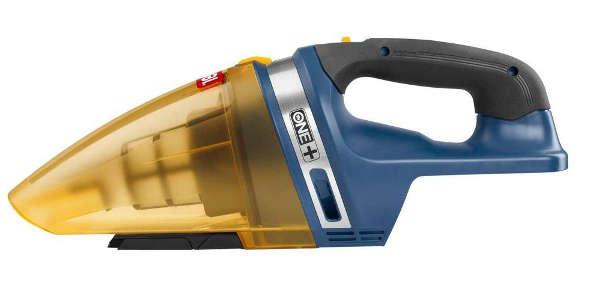 With all the talk about the new Bosch VAC120 Dust Extractor and the Milkwaukee M12 Compact Hand Vacuum coming out this year, I was getting excited to try one – especially the Bosch because I already own the batteries and charger.
With all the talk about the new Bosch VAC120 Dust Extractor and the Milkwaukee M12 Compact Hand Vacuum coming out this year, I was getting excited to try one – especially the Bosch because I already own the batteries and charger.
It turns out there was already another pretty good offering I was missing, the Ryobi 18V ONE+ hand vac. I also just happened to have a Lithuim ONE+ battery and charger sitting around. Picking up the vac for $25 seemed like a good deal – too good to pass up.
The Ryobi 18V ONE+ hand vac is very reminiscent of the more classic Dustbuster design, only a little heavier and engineered with a replaceable battery. I’ve owned a few Dustbusters over the years and have been pretty happy with them while their batteries lasted, but inevitably after a year or two their non-replaceable batteries just doesn’t deliver the juice anymore.
(We’ve seen similar sentiments in a recent post about cordless Dustbusters’ awesomeness, with readers describing how their older Dustbusters’ batteries also eventually lost their charge capacity.)
The ONE+ hand vac has a two stage filter. The first stage is a wire screen to keep the biggest debris in the dust bowl, which is Ryobi’s term for the yellow plastic container that forms the nozzle and holds the debris, and out of the second replaceable paper accordion filter.
The vacuum comes with a crevice tool that stores on the bottom of the dust bowl. The crevice tool also has a slide-out brush.
Operation
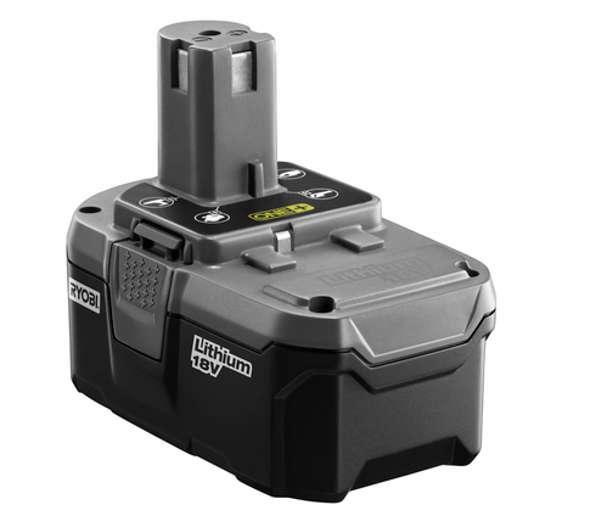
Using the Ryobi vacuum isn’t rocket science. Click a fully charged Ryobi 18V ONE+ battery into the vacuum and thumb the switch on. In this case I used my tried and true Ryobi P105 ONE+ high capacity Lithium-Ion battery. The battery has seen light use for a few years in my weed whacker and is still in good condition.
Ryobi lists the vacuum as weighing 2 lbs without the battery, but it’s more like 2 lbs 2 oz With the P105 battery it weighed a total of 3 lbs 10 oz.
The vacuum’s handle has a rubber overmold that actually feels pretty good in your hand. The on/off switch is easily accessible without changing your grip on the vacuum, but sliding the switch on and off is a little stiff.
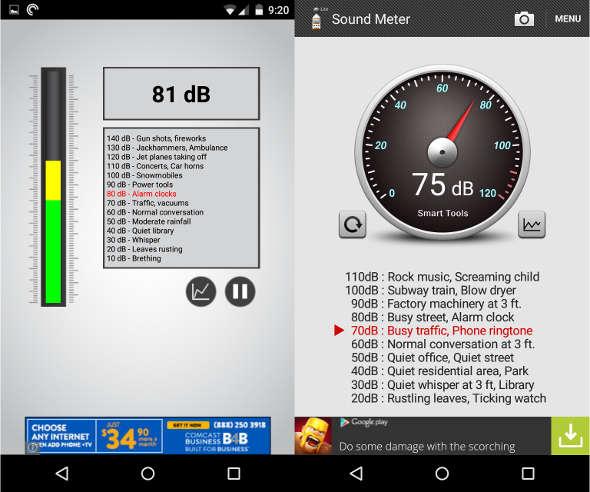
This little vacuum makes a lot of noise, so I measured the how loud it was with two different apps on my phone. I recorded 75-81 dB, depending on which app I used. For comparison, my benchtop table saw registered about 75 -80 dB, and my 12″ miter saw about 80-90 dB, in the same apps.
 Once you start using the vacuum, eventually you’ll run out of room in the dust bowl. To empty the hand vac, first you need to separate the dust bowl from the body of the vacuum by pressing the release button on top next to the dust bowl.
Once you start using the vacuum, eventually you’ll run out of room in the dust bowl. To empty the hand vac, first you need to separate the dust bowl from the body of the vacuum by pressing the release button on top next to the dust bowl.
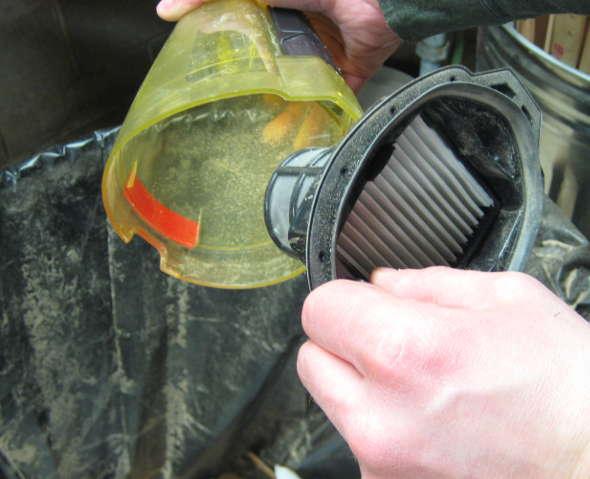
Then, you need to remove the filter assembly from the dust bowl, preferably over a rubbish bin, and dump out the debris. Just grab one of the larger tabs on the top or bottom and pull it out of the dust bowl. While you’re doing this you might as well clean off the wire screen.
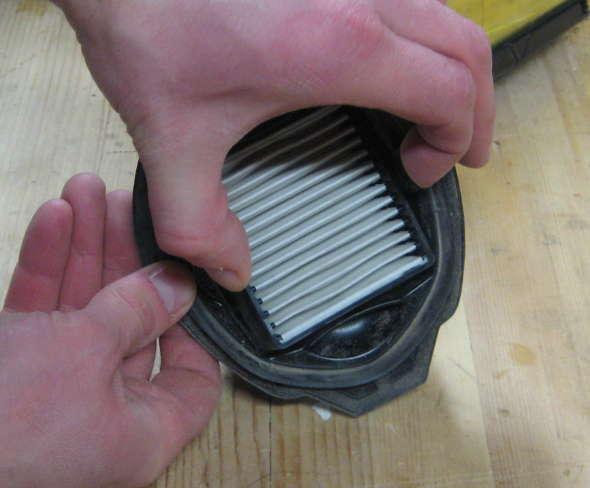
The replaceable paper filter can be accessed by squeezing the two tabs on the side of the filter and pulling it out of the filter assembly. I read one user review where they said they lost the filter when they emptied the dust bowl. I find this had to believe unless one of the tabs was broken. This filter isn’t going to accidentally fall out.
Battery Runtime Tests
For all of the tests I used a freshly charged Ryobi P105 ONE+ high capacity Lithium-Ion battery.
- I walked around my shop and later the rest of my house, vacuuming up any dirt or dust I could find. I used a stop watch to mark the amount of time the vacuum ran. I ended up having to stop the stopwatch a few times to empty the bin or change rooms, but the ONE+ hand vac shut off completely dead after around 19 minutes use. I was a little concerned that the vac had died, but after I charged the battery the vac roared back to life.
- Next, I wanted to see what happened in a worst-case scenario. A vacuum under no load is going to draw the most current from the battery, so I just left the vac on the bench to run for 5 minutes at a time and then leaving it rest for 5 minutes. I repeated this sequence until the battery died. Under these circumstances the battery lasted for 17 minutes.
- In the last two tests, neither the battery or vacuum itself got appreciably warm, so to get one more data point I just turned on the vacuum and let it sit on my workbench until it died. This time it lasted for 16 minutes.
During the entirety of the test, the vacuum maintained about the same level of suction and (correspondingly) the same level of noise for the first 80% or so of run time. After that, you could hear the motor start to run down and then suddenly stop when the battery was fully depleted.
Surfaces and Types of Debris
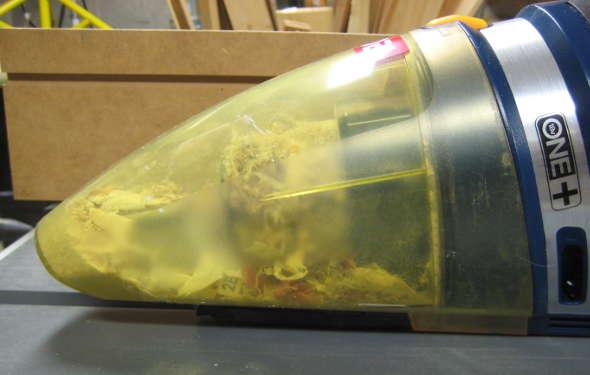
I used the vacuum almost daily for a few weeks try to catch the balls of dog hair and dirt that accumulated in the kitchen and hallway where we keep our German Shepard puppy. I found the vacuum did an adequate job picking up the hair on hard surfaces and it had enough suction to pull in the hair from several inches away from the intake. I didn’t have to recharge it at all over a two week period.
I also used the hand vac when I was coping the corners of the base I was installing in our family room. It handled picking up both the bigger saw dust from the coping saw and the finer dust from filing. Of course this was on a hard floor.
Every time I tried vacuuming dog hair, saw dust, shavings, or dirt from our low pile carpets, I found the vacuum to be practically useless. Sure it could pick up some gravel on the top of the carpet, but the other materials just clung to the carpet. The brush on the crevice tool wasn’t helpful either. I would slide the brush out, but it wouldn’t stay put.
I also found that the wire screen filter would get clogged to the point of losing most suction well before the dust bin was full.
Conclusion
To get the run time of the Ryobi hand vac for the various available Ryobi batteries, I rounded down the run time from my battery tests to 15 minutes. You can usually expect to see longer runtime in many cases, especially with a fresh battery. Since I used a P105 battery with a rating of 48Wh, this translates into 0.31min/Wh. Knowing this I built the following table of approximate expected run times.
Image Model Capacity Expected Runtime P100 27Wh ~8.4 min P102 24Wh ~7.5 min P105 48Wh ~15 min P107 28Wh ~8.8 min P108 72Wh ~22.5 min
This really isn’t a tool that you want to use to vacuum any kind of square footage. While the hand vac lasted between 16 and 19 minutes in my tests, I can’t see anybody EVER running a vacuum like this for that long and keeping their sanity. So the even 7.5 minute run time the P102 battery would provide would be plenty for most of my use.
Some of the downsides are:
Emptying the vacuum is more of a pain than it should be, because you have to remove the dust bowl/hopper and then remove the filter assembly out of the hopper before you can empty it.
The ONE+ hand vac works well on hard surfaces, but not so well on carpet and upholstery. Then again to work well on these surfaces you either need shop vac-like suction or a beater brush of some sort.
The crevice tool is annoying. It’s hard to remove, and then you have to turn it 180 degrees to stick it into the vacuum opening. The crevice tool has an attached brush that you slide forward to use, but the brush doesn’t stay in place. It would be nice if the vacuum opening was a standard size so you could use the vacuum with standard Shop-Vac and wet/dry vac attachments.
Here’s the good news:
If you are already invested in the Ryobi 18V ONE+ system, the ONE+ hand vac will only run you $25 for a bare tool at Home Depot online or at the store.
Replacement filters cost about $4 and are only available online at the Home Depot. Several people in online reviews have complained that they had a hard time getting a replacement filter, but I ordered one to ship to Home Depot and picked it up several days later with no problem.
Buy Now (ONE+ Hand Vac via Home Depot) Buy Now (Filter via Home Depot)
A new version of the Ryobi ONE+ vac came out in 2015. According to Ryobi, it’s basically the same vac but with an updated look:
The new green version is very similar to the previous blue one. Just updated the color and overmold to match the new brand language.
Buy Now(New version via Home Depot)

